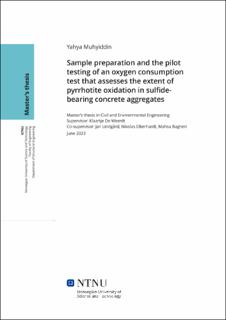| dc.contributor.advisor | De Weerdt, Klaartje | |
| dc.contributor.advisor | Lindgård, Jan | |
| dc.contributor.advisor | Oberhardt, Nikolas | |
| dc.contributor.advisor | Bagheri, Mahsa | |
| dc.contributor.author | Muhyiddin, Yahya | |
| dc.date.accessioned | 2023-09-20T17:19:39Z | |
| dc.date.available | 2023-09-20T17:19:39Z | |
| dc.date.issued | 2023 | |
| dc.identifier | no.ntnu:inspera:146720801:35443642 | |
| dc.identifier.uri | https://hdl.handle.net/11250/3090886 | |
| dc.description.abstract | Når betongtilslag inneholder magnetkis, et mineral som består av jern og svovel, kan dette føre til betydelige skader på betongkonstruksjoner. I 2016 ble en kanadisk testprosedyre introdusert. Målet med denne testprosedyren er å finne ut hvilke sulfidholdige tilslag som eventuelt kan brukes i betong.
Denne masteroppgaven har fokus på trinn to i den kanadiske testprosedyren, nemlig the oxygen consumption test, «OCT». Testen måler hvor mye oksygen som forbrukes av tilslagsmaterialet i en hermetisk lukket reaksjonscelle (beholder) i løpet av tre timer. Prøver fra fire tilslagstyper, to fra Norge og to fra Canada, ble preparert og etterpå testet med OCT som en del av denne oppgaven. Fokuset var å bidra til å bygge opp et eksperimentelt oppsett for OCT i Norge, samt vurdere om resultatene man får er fornuftige. Oppredningen av tilslag var spesielt satt i fokus, og målet var å utvikle en oppredningsprosedyre som både er effektiv og fri for kontaminering.
Det eksperimentelle oppsettet hos SINTEF Betonglaboratoriet er fult operativt. En oppredningsprosedyre som kombinerer wolfram- og stålutstyr, er funnet å være effektiv og med lav risiko for kontaminering av prøver.
Partikkelstørrelsen til tilslagsmaterialet er en av de viktigste parameterne til OCT. Partikkelstørrelsen til testprøvene ble bestemt gjennom sikting og gjennom en optisk metode (laser scattering). Store forskjeller mellom de to metodene ble avdekket, spesielt siden den optiske metoden viser større antall partikler <75 μm og >150 μm.
Alt i alt, resultatene fra OCT virker rimelige, spesielt for de norske tilslagene. Resultatene for de kanadiske tilslagene var mye lavere enn referanseverdiene i Canada, noe som kan tyde på en systematisk feilkilde som kunne ha påvirket resultatene fra pilot-testingen. En mulig feilkilde burde derfor undersøkes nærmere.
Et av de norske tilslagene ble testet i OCT med en lengere testperiode (16.7h sammenlignet med 3.5h). Den nye testperioden førte til betydelig høyere oksygenforbruk i reaksjonscellen.
Gjennom erfaringen fra denne masteroppgaven, og litteraturstudiet om OCT, ble det mulig å utvikle en norsk OCT-prosedyre som inkluderer oppredning av tilslagsmaterialet. | |
| dc.description.abstract | The presence of pyrrhotite, a mineral consisting of iron and sulfur, in concrete aggregates can cause considerable damage to concrete structures. In 2016, a Canadian testing protocol was introduced, the aim of which was to investigate whether sulfide-bearing aggregates can be safely used in concrete.
This master’s thesis focused on the second step of the Canadian testing protocol, the oxygen consumption test (OCT). This test measures the oxygen consumption of aggregate material in a hermetically closed cell over three hours. Samples from four aggregates, two Norwegian and two Canadian, were prepared and then tested with the OCT as part of this study. The focus was to help establish the experimental setup of the OCT in Norway and to assess whether that the obtained results are reasonable. The process of sample preparation, in particular, was investigated, and the aim was to develop a methodology that was both efficient and contamination-free.
The OCT setup at the SINTEF Concrete Laboratory is fully operative. One sample preparation process involving steel and tungsten carbide equipment was preliminarily found to be efficient and free of iron contamination.
The particle size of the aggregate material is one of the parameters of the OCT. The particle size of test samples was determined both by sieving and by laser scattering (optical technique). The two methods gave significantly different particle size distributions.
The OCT results (oxygen consumption) seem reasonable, particularly for the Norwegian aggregates. However, the results for the two Canadian aggregates were significantly lower than the oxygen consumption reported by earlier work on the OCT in Canada. This might be due to a systematic source of error that requires further investigation.
Testing on one of the Norwegian aggregates preliminarily showed that increasing the duration of the OCT (to 16.7h) can lead to significantly higher oxygen consumption.
A detailed procedure for the oxygen consumption testing in Norway, including the sample preparation process, was developed based on the existing literature on the OCT and the experience acquired through the work on the master’s thesis. | |
| dc.language | eng | |
| dc.publisher | NTNU | |
| dc.title | Sample preparation and the pilot testing of an oxygen consumption test that assesses the extent of pyrrhotite oxidation in sulfide-bearing concrete aggregates | |
| dc.type | Master thesis | |
